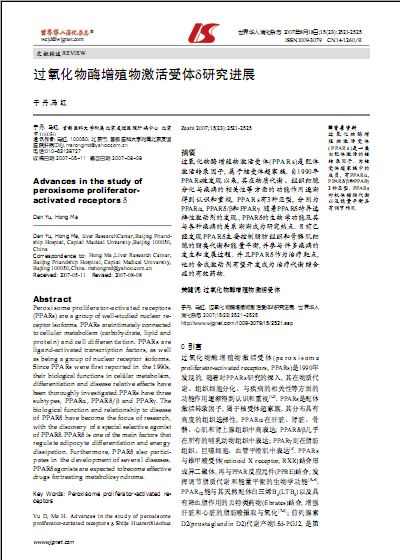过氧化物酶增殖物激活受体d研究进展
于丹,马红,通讯作者:,Advancesinthestudyofperoxisomeproliferator-activatedreceptorsd,DanYu,HongMa,Correspondenceto:,Received:,Revised:
 |
| 第1页 |
参见附件(780KB,5页)。
于丹, 马红, 首都医科大学附属北京友谊医院肝病中心 北京市 100050
通讯作者: 马红, 100050, 北京市, 首都医科大学附属北京友谊医院肝病中心. mahongmd@yahoo.com.cn
电话: 010-63138727
收稿日期: 2007-05-11 修回日期: 2007-08-08
Advances in the study of peroxisome proliferator-activated receptorsd
Dan Yu, Hong Ma
Dan Yu, Hong Ma,Liver Research Center, Beijing Friendship Hospital, Capital Medical University, Beijing 100050, China
Correspondence to:Hong Ma, Liver Research Center, Beijing Friendship Hospital, Capital Medical University, Beijing 100050, China. mahongmd@yahoo.com.cn
Received:2007-05-11 Revised:2007-08-08
Abstract
Peroxisome proliferator-activated receptors (PPARs) are a group of well-studied nuclear receptor isoforms. PPARs are intimately connected to cellular metabolism (carbohydrate, lipid and protein) and cell differentiation. PPARs are ligand-activated transcription factors, as well as being a group of nuclear receptor isoforms. Since PPARs were first reported in the 1990s, their biological functions in cellular metabolism, differentiation and disease relative effects have been thoroughly investigated. PPARs have three subtypes, PPARa, PPARd/b and PPARg. The biological function and relationship to disease of PPARd have become the focus of research, with the discovery of a special selective agonist of PPARd. PPARd is one of the main factors that regulate adipocyte differentiation and energy dissipation. Furthermore, PPARd also participates in the development of several diseases. PPARd agonists are expected to become effective drugs for treating metabolic syndrome.
Key Words: Peroxisome proliferator-activated receptors
Yu D, Ma H. Advances in the study of peroxisome proliferator-activated receptorsd. Shijie Huaren Xiaohua Zazhi 2007; 15(23): 2521-2525
摘要
过氧化物酶增殖物激活受体(PPARs)是配体激活转录因子, 属于核受体超家族. 自1990年PPARs被发现以来, 其在物质代谢、组织细胞分化与疾病的相关性等方面的功能作用逐渐得到认识和重视. PPARs有3种亚型, 分别为PPARa, PPARd/b和PPARg ......
您现在查看是摘要介绍页,详见PDF附件(780KB,5页)。